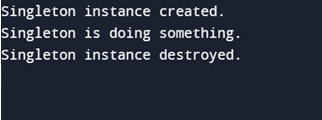Private Destructor in C++
C++ is a powerful programming language that can handle both high-level abstractions and low-level memory management. Destructors are one of the primary factors that lead to this. Destructors are required in C++ applications to manage resources and ensure proper cleanup. This article will go through the concept of destructors, their importance, how they work, and the best practices for using them effectively.
Objects are instances of classes that contain data and behavior in object-oriented programming. Constructors are used to start things off, but what happens when an object is no longer required? In this case, destructors are employed. A destructor is a sort of class member function that is called when an object is removed or exits the scope.
Destructors are responsible for returning any resources gathered by an item throughout its lifetime. Dynamically allocated memory, file handles, network connections, and other external resources must all be relinquished effectively to minimize memory leaks or resource depletion.
Syntax:
The syntax for defining a destructor is straightforward. It is identical to the class name but preceded by a tilde (). For example, if the class is named MyClass, the destructor will also be named MyClass. Here's an example of a fundamental destructor:
Private Destructors:
C++ is a robust programming language with various memory and resource management capabilities. The ability to mark a destructor as private is an intriguing feature of C++. Destructors are generally public class member methods; however, making them private may result in unique design patterns and more control over object lifetimes.
Before we go into private destructors, let's go over how destructors and access specifiers work in C++. A destructor is a class member function that cleans up resources when an object escapes scope or is purposefully destroyed. Access specifiers (public, protected, and private) govern the visibility and accessibility of class members from outside the class.
One of the primary use cases of destructors is to manage resources:
- When objects allocate memory using new or malloc, it is vital that the memory be relinquished using delete or free. Destructors provide a convenient place for this cleanup, which prevents memory leaks.
- In their destructors, objects that manage file handles must close those handles. It prevents files from being opened once their associated objects are no longer needed.
- Network Connections: Objects that make network connections (for example, sockets) can use destructors to terminate the connections and prevent resource depletion gracefully.
- Destructors are also used in circumstances where reference counting is required, where objects maintain track of the number of references to them. When the reference count hits zero, the destructor is called to release the resources.
The execution of destructors is automatic and deterministic. When an object goes out of scope, either at the end of its block or when a function returns, the destructor is called for that object. Consider the example below:
Example:
Output:

Advantages of Private Destructors:
There are several advantages of private destructors. Some main advantages of private destructors are as follows:
- Preventing Intentional Deletion: Making a destructor private prohibits users from purposefully deleting objects from that class. It is important if you want to ensure that things are destroyed only under certain, controlled circumstances.
- Enforcing Ownership Models: You may enforce ownership models by restricting object deletion to certain methods inside the class, ensuring that objects are handled appropriately in accordance with the design requirements.
- Custom Cleanup code: Private destructors can be used to create custom cleanup code before an object is destroyed. It allows for more precise resource management, such as closing files, releasing memory, or telling other parts of the software that the object has been destroyed.
- Implementing Singletons: The Singleton design pattern restricts a class's instantiation to a single instance. A private destructor can be used to restrict the creation of new instances while still guaranteeing that the singleton instance is correctly handled.
- Complex System Resource Management: Certain components of big software systems may necessitate extensive resource management. The resource management logic is contained within the class using private destructors, making it easier to maintain and improve over time.
Uses for Private Destructors:
There are several uses of private destructors. Some main advantages of private destructors are as follows:
- The Singleton pattern enables for just one instance of a class to exist. A private destructor ensures that the instance cannot be removed from outside the class, preserving the uniqueness of the singleton.
- Smart Pointer Resource Management: Smart pointers, such as std::shared_ptr and std::unique_ptr, may manage bespoke resources with private destructors. For example, customized shared_ptr implementation may require a private destructor to enable adequate reference counting and resource cleanup.
- Encapsulation of Complex Behaviour: When a class's initialization and cleanup requirements are complex, a private destructor can encapsulate the cleanup code and enforce the proper sequence of events.
- Private destructors provide a regulated approach to object lifetimes, enforce ownership models, and manage resource utilization in C++. By forbidding object deletion outside of the class, developers may implement design principles, isolate cleanup functions, and impose specialized resource management. However, careful consideration and understanding of object lifetimes are required for efficient implementation, resulting in more robust, encapsulated, and maintainable code.
|

 For Videos Join Our Youtube Channel: Join Now
For Videos Join Our Youtube Channel: Join Now










